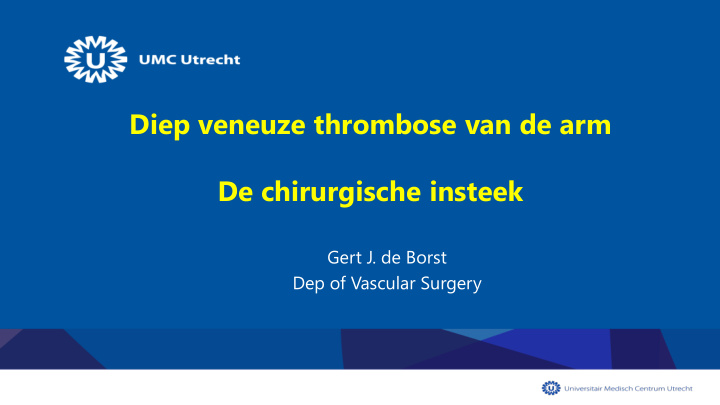



Diep veneuze thrombose van de arm De chirurgische insteek Gert J. de Borst Dep of Vascular Surgery
Disclosure belangen spreker GJ de Borst UMC Utrecht Geen (potentiële) belangenverstrengeling Voor bijeenkomst mogelijk Bedrijfsnamen relevante relaties: • • Sponsoring of Bayer BV; Braun Medical onderzoeksgeld • • Honorarium of andere (financiële) vergoeding • • Aandeelhouder • • Andere relatie, namelijk …
Oral anticoagulation Surgery Treatment PTA CDT
Treatment options • Conservative • DOAC /anticoagulation (for at least 3 M) • Elastic stockings • Invasive • Catheter directed thrombolysis (CDT) • Decompression surgery • Based on specialist preference: – Additional Percutaneous Transluminal Angioplasty (PTA) +/- stent – Post-op anticoagulation Dutch Internal Medicine Guideline on antithrombotic management, 2015
Treatment options (2) Invasive treatment (4- Complication Conservative treatment (4-11) 11) Post-thrombotic syndrome (PTS) 26-66% 4-25% Symptomatic pulmonary embolism +/- 7% +/-1% Rethrombosis rate 0-5% 0-5% Surgical complications* - 3-25% *E.g. pneumothorax, hemothorax, surgical site infection, brachial plexus injury. 4. Peek et al, 2017 5. Grant et al, 2012 6. Vazquez et al, 2017 7. Kahn et al, 2006 8. Thomas et al, 2005. 9. Lugo et al, 2015. 10. Sajid et al, 2007 11. Doyle et al, 2013
7 Before surgery After surgery
Resultaten (1)
Current evidence • Only retrospective studies • Small case series • No comparative studies (with sufficient FU) • No RCTs → Lack of high quality evidence → Varying guideline recommendations
Guideline recommendations Guideline Standard therapy Catheter directed thrombolysis (CDT) Decompression surgery British Committee for Heparin anticoagulation for 5 days. No routine CDT prior to decompression No recommendations. → Warfarin for 3 to 6 months. (2B) standards in Haematology surgery (2B). American College of Chest Initially therapeutic LMWH, UFH or CDT only in selected patients with low Only after failed anticoagulant or Physicians fondaparinux (1C). bleeding risk and severe symptoms (2C). thrombolytic treatment. (2C) → Vitamine K antagonist for ≥3 months (1C) International society of Vitamine K antagonist for 3 months. No recommendations Only in severe vTOS to avoid thrombosis and Continued anticoagulation for continued anticoagulation. haemostasis persistent vTOS or severe PTS. Dutch internal medicine DOAC anticoagulation treatment for CDT only in carefully selected young patients Only in selected patients with very guideline at least 3 – 6 months. with extensive thrombosis and risk of severe severe TOS. limb damage or limb loss.
Conclusions • Current evidence is insufficient to determine the most clinically- and cost-effective treatment • A randomised controlled trial is highly warranted !
UTOPIA trial
Research question Does surgical treatment, consisting of catheter directed thrombolysis and first rib resection, significantly reduce postthrombotic syndrome occurrence, compared to conservative therapy with DOAC anticoagulation, in adults with primary upper extremity deep vein thrombosis due to Paget Schroetter syndrome ?
Utopia trial • Design: Multicenter randomised controlled trial • Population: All adults with first case of primary UEDVT • Primary outcome: Occurence of postthrombotic syndrome according to the modified Villalta score • Secondary outcomes: • Quality of life • Severity of PTS • Serious adverse events/ procedural complications • Cost-effectiveness
• Inclusion, informed consent and randomisation at first presentation in emergency department or outpatient clinic • Inclusion criteria: • ≥18 years old • Mentally competent • Symptoms <14 days old • Exclusion criteria: • Secondary upper extremity deep vein thrombosis • Any contra-indication for DOAC or catheter directed thrombolysis • Any Indication for lifelong anticoagulation treatment
• CTv is required to compare baseline characteristics of both groups. ( what’s the underlying cause for thrombosis? vTOS or idiopathic?)
Invasive treatment Conservative treatment Decompression surgery either through • • DOAC: Rivaroxaban or apixaban transaxillary or infraclavicular approach • Minimum of 3 months Perioperative PTA or venolysis on indication •
• Villalta score adapted for use in upper extremity • Veines-Sym/QOL: Validated QOL questionnaire for venous disease. • EQ5D: for cost-effectiveness analysis
• Determine primary endpoint: Presence of PTS after 12 months follow up • Control CTv to assess vein patency at last follow-up. Rethrombosis or (re)stenosis present?
Sample size & power calculation Sample size • – Effect size: 20% PTS reduction in favour of invasive treatment – Two sided p-value: 0,05 – Power: 80% – Estimated loss to follow up: 10% • Total sample size: 78 patients per arm → 156 patients
Oral anticoagulation Surgery Treatment PTA CDT
De Patient & vasculaire connectie “Trombosearmen komen weinig voor. De informatie rond • trombosearmen op internet is beperkt”. “Het is teleurstellend dat ik zelf, na eigen onderzoek, heb • moeten vaststellen dat de geboden behandeling bij mijn acute trombose niet de enige behandeling is”.
Treatment CDT PTA
Huidige centra
Recommend
More recommend